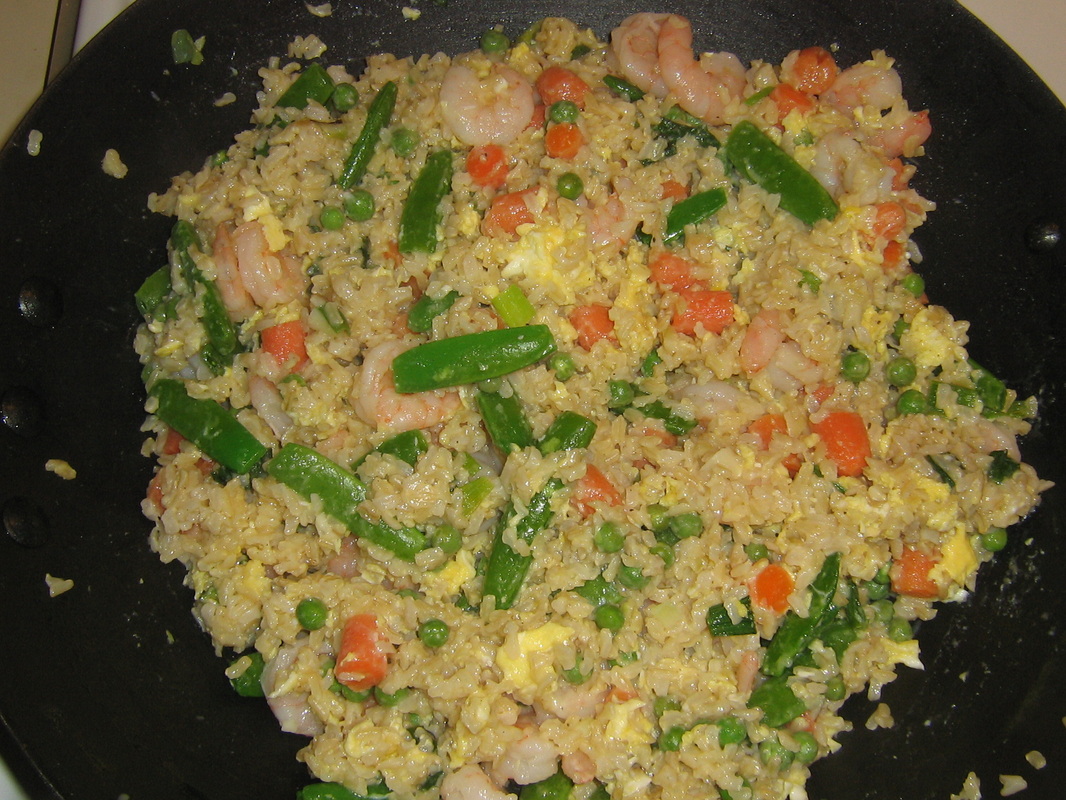I needed an excuse to break out my wok so fried rice was in order for tonight. Definitely not a traditional fried rice recipe as this doesn't even include soy sauce, but I thought it was was pretty tasty. I made this healthier by using brown rice. Remember that fried rice is always better when you use day old rice because it will be easier to fry, so try to remember to cook it the night before.
Source: rachelraymag.com
- 2 cups long-grain rice, rinsed
- 6 tablespoons extra-virgin olive oil
- 1 pound large shrimp, peeled and deveined
- 1 8 ounce bag sugar snap peas, trimmed
- Salt and pepper
- 1/2 bunch scallions (3 to 4), green and white portions thinly sliced separately
- 3 cloves garlic, finely chopped
- 4 large eggs, beaten
- 1 10 ounce bag frozen peas and carrots, thawed
- In a medium saucepan, bring the rice and 2 cups water to a boil; lower the heat, cover and simmer until the water is absorbed, about 20 minutes. Let stand, covered, for 5 minutes.
- Meanwhile, in a large nonstick skillet, heat 3 tablespoons olive oil over medium-high heat. Add the shrimp and cook for 2 minutes. Stir in the sugar snap peas, season with salt and pepper and cook until the shrimp is opaque, about 1 minute. Transfer to a large bowl.
- Place the skillet over medium-high heat and add the remaining 3 tablespoons olive oil, the scallion whites and garlic. Cook, stirring, until the garlic sizzles, about 30 seconds. Stir in the rice, season with salt and pepper and spread into an even layer. Cook until slightly browned, 3 to 4 minutes. Stir and cook for 3 minutes more. Push the rice to one side of the pan; add the eggs, season with salt and cook, scrambling, until set, 1 to 2 minutes. Stir the eggs into the rice, then add the shrimp mixture, peas and carrots and scallion greens and cook, stirring, until heated through.
Woks!
I love my wok! But did you know you should season a new one? Here's how:
How to Season a Wok
By an eHow
Seasoning a carbon-steel wok, like seasoning a cast-iron skillet, seals the cooking surface and prevents rust. A well-seasoned wok doesn't need a lot of oil, because food doesn't stick to it.
Wash the new wok with hot water and mild soap.
Wash the new wok with hot water and mild soap.
Rinse well.
Place wok on stove over medium heat.
Fold a paper towel into a small square, and then soak it with fresh vegetable oil.
Wipe the hot wok until it is completely covered with a thin film of oil.
Switch to a clean paper towel pad and continue wiping the wok until it is completely covered with a thin film of hot oil.
Turn the heat to low and let the wok heat for 15 minutes
Let the wok cool, and then use.
Reseason the wok if food sticks to the wok.

 RSS Feed
RSS Feed